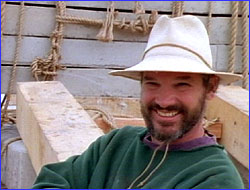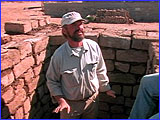
|
 |
 |
Roger Hopkins, Stonemason NOVA: Can you describe what your everyday work is like when you're not called off to Egypt to help raise an obelisk? HOPKINS: I have a landscape stone masonry business called Naturalistic Gardens in Sudbury, MA. We build waterfalls, carve sculpture work, and install patios and walkways. NOVA: Have you had any previous experience on a project like the obelisk raising? HOPKINS: This is my fourth project for NOVA. We built a small pyramid, I worked on the Stonehenge project, we already tried once to raise an obelisk, and now we're trying again. NOVA: How important do you think your stone masonry skills are to the outcome of this new attempt? HOPKINS: I think it's good to bring a practical knowledge to any program where they're bouncing around all kinds of theories. NOVA: How will this attempt be different from the one in 1994? HOPKINS: We'll get it up this time—come hell or high water. NOVA: So what odds do you give the project of actually succeeding?
NOVA: Can you tell us more about the specific experiments you're going to be doing this time? HOPKINS: I'm going to show how they sawed and cut holes in the granite. Some of the finest stone sculpture work in the world was done there. NOVA: Do you still think that the sand method that you tried last time is the way that the Egyptians would have done it? HOPKINS: Some derivation thereof, I'm totally convinced. Well, I won't go out and say I'm "totally" convinced. I'd say I'm 80 percent sure that that's the way they would have done it, because it's the easiest. NOVA: Given how hard it seems to be to raise an obelisk that's not even as large as the largest ones ever quarried, how impressive do you find it that the ancient Egyptians managed to raise these objects? HOPKINS: I've found that when you're dealing with heavy stones, the larger they get, the whole dynamics of the game change. That's one of the problems with using small models: You can sometimes fudge the results that you couldn't get with a much heavier stone. So we can only come close to emulating or trying to duplicate what they did. But I think the work that the ancient Egyptians did was just totally mind-boggling. They were dealing with weights that are off the spectrum from modern day work.  NOVA: What do you expect to learn from this project?
NOVA: What do you expect to learn from this project?HOPKINS: I expect to bring to conclusion some of the wild speculation about how some of the stone work was done. Each time I go there, each time I'm involved in one of these projects, I learn something new. It's a cumulative thing. Sometimes I wish we could do the project three, four times, so we could get to a more adequate conclusion. Explore Ancient Egypt | Raising the Obelisk | Meet the Team Dispatches | Pyramids | E-Mail | Resources Classroom Resources | Site Map | Mysteries of the Nile Home Editor's Picks | Previous Sites | Join Us/E-mail | TV/Web Schedule About NOVA | Teachers | Site Map | Shop | Jobs | Search | To print PBS Online | NOVA Online | WGBH © | Updated November 2000 |
 Roger Hopkins
Roger Hopkins Always the joker, Hopkins (L) shares a laugh with
engineer Mark Whitby (R).
Always the joker, Hopkins (L) shares a laugh with
engineer Mark Whitby (R).